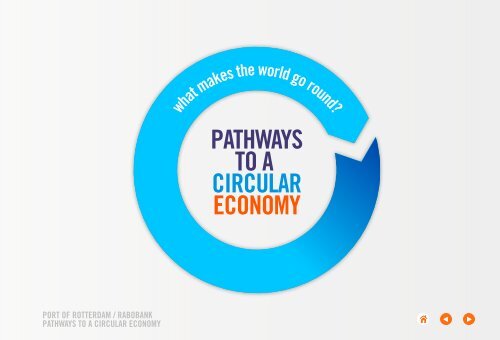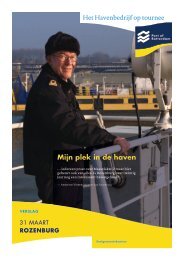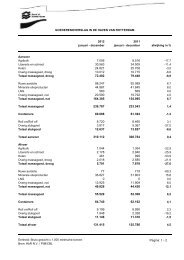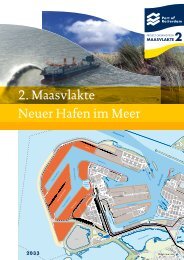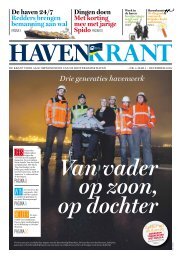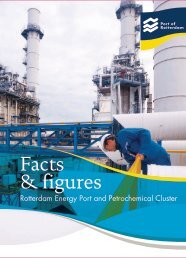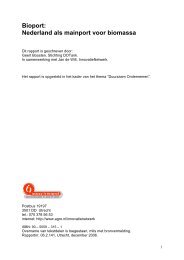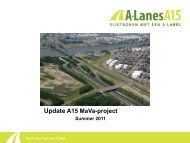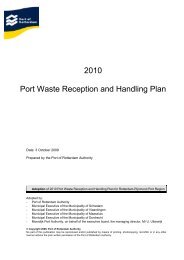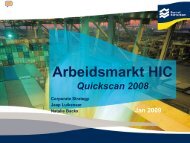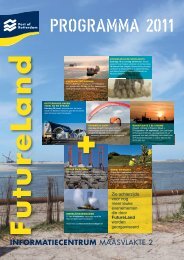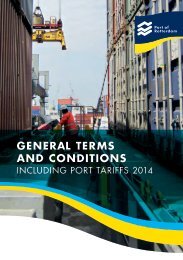PATHWAYS TO A CIRCULAR ECONOMY - Port of Rotterdam
PATHWAYS TO A CIRCULAR ECONOMY - Port of Rotterdam
PATHWAYS TO A CIRCULAR ECONOMY - Port of Rotterdam
Create successful ePaper yourself
Turn your PDF publications into a flip-book with our unique Google optimized e-Paper software.
ound?go world the makes what<strong>PATHWAYS</strong><strong>TO</strong> A<strong>CIRCULAR</strong><strong>ECONOMY</strong>PORT OF ROTTERDAM / RABOBANK<strong>PATHWAYS</strong> <strong>TO</strong> A <strong>CIRCULAR</strong> <strong>ECONOMY</strong>
PREFACEChange can be positive for the planet and for businessAs we look further into the 21st century, the world is facinga myriad <strong>of</strong> challenges – meeting the needs <strong>of</strong> a growingworld population with a finite resource base on a planetthat is already under stress. However, these challengesalso present opportunities – particularly for businessesthat are prepared to change. The model <strong>of</strong> a circulareconomy <strong>of</strong>fers plenty <strong>of</strong> scope to companies that arewilling to embrace change.The antiquated linear economy is based on the premise<strong>of</strong> take, make and use – a practice that generates wastewhich must be disposed <strong>of</strong> at every step. In a circulareconomy, companies make, improve and renew. Thecircular model is about optimising an entire chain ratherthan focusing separately on each link. There are fourprinciples that define the circular economy:Use less: minimise the use <strong>of</strong> inputs and eliminatewaste and pollution.Do more: maximise the value created at each stage.Manage resources: manage flows <strong>of</strong> bio-basedresources from and back into the biosphere, andrecover and retain flows <strong>of</strong> non-renewable resourcesin closed loops.Work together: establish mutually beneficial relationshipsbetween companies within each circular chain.The circular economy is about finding new opportunitiesfrom sharing ownership <strong>of</strong> the production, use and renewal<strong>of</strong> goods and services. By adopting a circular economymodel, businesses are actively looking for the upside intaking on the challenges that the world must inevitablyface.4/73PORT OF ROTTERDAM / RABOBANK<strong>PATHWAYS</strong> <strong>TO</strong> A <strong>CIRCULAR</strong> <strong>ECONOMY</strong>
Getting started with the circular economyThe good news is that many companies are ready to throwtheir shoulders to the wheel and adopt a circular economymodel. However, they are looking for specific guidance onwhat to do, where to do it and how to get started.What the circular economy could look likeWithin four specific areas – gas and carbon in the energysector, copper in the metals sector, plastic packaging inthe chemicals sector and aquaculture in the food andagriculture sector – we have constructed models that arepathways to the circular economy. They represent whatcould be achieved through concerted actions within thenext three to five years.The pathways are new. We have arranged each component– some existing and some new – to foster closecooperation between companies operating along thesefour chains and to embrace the principles <strong>of</strong> the circulareconomy.Where to get startedThe <strong>Rotterdam</strong>/Delta region is an ideal place to startbuilding pathways to a circular economy. The pathways wehave built are focused on getting started in this region.They show what may be possible if we take advantage <strong>of</strong>the many benefits this region has to <strong>of</strong>fer: the presence <strong>of</strong>many companies, an industrial cluster, availability <strong>of</strong>supporting infrastructure, sizeable resource flows, and anopen and supportive business network.How to get startedThe pathways to a circular economy reveal a series <strong>of</strong> steps– a transition from the current system towards a circulareconomy. Many understand this means fundamentalchange but do not understand how the transition couldtake place. We show the move from linear to circularmodels through four stages that represent an evolutionarypathway to circularity.5/73PORT OF ROTTERDAM / RABOBANK<strong>PATHWAYS</strong> <strong>TO</strong> A <strong>CIRCULAR</strong> <strong>ECONOMY</strong>
Creating a new futureBusiness is already engaged in the concept <strong>of</strong> the circulareconomy, and the four pathways presented in this reportdemonstrate what may be possible in the <strong>Rotterdam</strong>/Deltaregion, provided business engagement can be convertedto a preparedness to act. We present a ten-point actionplan that would enable business to take action:1 Establish leadership2 Generate community support3 Build knowledge4 Foster innovation to risk management5 Provide infrastructure6 Set rules and standards7 Provide finance on a supply chain basis8 Finance use, not ownership9 Create a more circular approach10 Enact supporting policyThe journey to a circular economy needs to start. Thisreport defines four pathways in the <strong>Rotterdam</strong>/Delta regionthat could, with the right enabling environment, capitaliseon business’ willingness to build a circular economy.We are ready to walk down these pathways and we inviteyou to join us.Coert BeermanCEO Rabobank <strong>Rotterdam</strong>Hans SmitsCEO <strong>Port</strong> <strong>of</strong> <strong>Rotterdam</strong>6/73PORT OF ROTTERDAM / RABOBANK<strong>PATHWAYS</strong> <strong>TO</strong> A <strong>CIRCULAR</strong> <strong>ECONOMY</strong>
1# THE NEED<strong>TO</strong> PROGRESSALONG <strong>PATHWAYS</strong><strong>TO</strong> A <strong>CIRCULAR</strong><strong>ECONOMY</strong>7/73PORT OF ROTTERDAM / RABOBANK<strong>PATHWAYS</strong> <strong>TO</strong> A <strong>CIRCULAR</strong> <strong>ECONOMY</strong>
– A growing recognition that the world is movingbeyond planetary boundaries, along with short-termchallenges posed by resource scarcity, meanbusinesses need to start thinking and actingdifferently. Moving to a circular economy mayprovide an important potential solution.Reorganising business activities to minimise inputs,maximise the value <strong>of</strong> outputs and eliminate waste aswell as rethinking interactions with the biosphere andmaintaining the value <strong>of</strong> non-renewable resources,provide a new model for growth and sustainabledevelopment.8/73PORT OF ROTTERDAM / RABOBANK<strong>PATHWAYS</strong> <strong>TO</strong> A <strong>CIRCULAR</strong> <strong>ECONOMY</strong>
The challenge for the planet and its peopleThe challenge Rockström presented to governments,businesses and the community – 40 years after the Club <strong>of</strong>Rome began discussions on limits to growth – was to bringhuman activities back within the safe operating spaces <strong>of</strong>our planetary systems. Meeting Rockström’s challenge canonly be achieved through an improvement in resourceefficiency; improvement that needs to be radical in theplanetary systems that have already passed outside theirsafe operating spaces as well as those where business asusual would lead to a similar outcome.– Human activities havealready moved outsidethe safe operating spaces<strong>of</strong> three planetarysystems.Furthermore, transformative action is going to beneeded – human activities need to be rethought and reengineered.Change <strong>of</strong> this magnitude is not just aboutmaking incremental improvements in eco-efficiency (i.e.traditional productivity gains that can be thought <strong>of</strong> as‘doing things better’). Instead, businesses also need to ‘dobetter things’, by acting in ways that create step changesin productivity through the redesign <strong>of</strong> processes. This willrequire a focus on eco-effectiveness (i.e. a transition to asystem where waste is seen as resource to biological ortechnological processes).10/73PORT OF ROTTERDAM / RABOBANK<strong>PATHWAYS</strong> <strong>TO</strong> A <strong>CIRCULAR</strong> <strong>ECONOMY</strong>
Figure 1: Human activities havemoved outside planetaryboundariesThe globe represents the proposedsafe operating space for nineplanetary systems. The wedgesrepresent an estimate <strong>of</strong> the currentposition for each variable.CHEMICALPOLLUTION(not yet quantified)CLIMATECHANGEOCEANACIDFICATIONSource: Johan Rockström et al. Nature461, 472-475 (24 September 2009) andIda Kubiszewski/Solutions.ATMOSPHERICAEROSOL LOADING(not yet quantified)STRA<strong>TO</strong>SPHERICOZONE DEPLETIONBIODIVERSITYICSSBIOGEOCHEMISTRY:NITROGEN CYCLEBIOGEOCHEMISTRY:PHOSPHORUS CYCLECHANGE INLAND USEGLOBALFRESHWATER USE11/73PORT OF ROTTERDAM / RABOBANK<strong>PATHWAYS</strong> <strong>TO</strong> A <strong>CIRCULAR</strong> <strong>ECONOMY</strong>
Adopting circular models creates opportunitiesfor businessThe challenge to stay within and, where necessary, tomove back inside the safe operating spaces <strong>of</strong> planetarysystems applies to business as well as governments andcommunities. For businesses, this challenge applies bothindividually and collectively to all companies, and for mostthis means more effectively harnessing value chains. It alsomeans continuing to look for opportunities to increaseproductivity along the chain by adding more value at eachstage, and avoiding the generation <strong>of</strong> waste.In fact, the notion <strong>of</strong> waste (i.e. by-products that need tobe disposed <strong>of</strong>) should be replaced by the idea <strong>of</strong> resourceflows; so that nothing is lost in industrial processes (i.e.everything is reused or transformed). Biological resourcesshould flow from the environment for use in industrialprocesses, and then be safely returned when they are nolonger required. Non-renewable resources should remainin cycles where they are used and reused, without losingtheir value.Circular, not linearThe easiest way for companies to meet this challenge isby shifting their operations from a linear model to a circularmodel (see Figure 2). The linear model is based on thepremise <strong>of</strong> take, make and use, which generates wastethat must be disposed <strong>of</strong> at each step <strong>of</strong> the process. Thecircular model is about optimising systems (i.e. value chains),– Companies need toshift their operationsfrom a linear model toa circular model.12/73PORT OF ROTTERDAM / RABOBANK<strong>PATHWAYS</strong> <strong>TO</strong> A <strong>CIRCULAR</strong> <strong>ECONOMY</strong>
ather than focusing on just one component in a chain. Inthe circular model, companies make, improve and renew.There are four principles that define the circular economy:1 Minimise the use <strong>of</strong> inputs and eliminate waste andpollution.2 Maximise the value created at each stage.3 Manage flows <strong>of</strong> bio-based resources from andback into the biosphere, and recover and retainflows <strong>of</strong> non-renewable resources in closed loops.4 Establish mutually beneficial relationships betweencompanies within each circular chain.Opportunities, not problemsThe circular economy is about looking for the upside inthe inevitable challenges that businesses are facing.Companies that are already engaged in the concept <strong>of</strong>the circular economy are facing up to these challenges,and in doing so, are finding new opportunities from sharingownership <strong>of</strong> the production, use and renewal <strong>of</strong> goodsand services.13/73PORT OF ROTTERDAM / RABOBANK<strong>PATHWAYS</strong> <strong>TO</strong> A <strong>CIRCULAR</strong> <strong>ECONOMY</strong>
Figure 2: Shifting from linearto circular models will createnew opportunitiesSource: Rabobank, 2012LINEAR LINEAR <strong>ECONOMY</strong> <strong>ECONOMY</strong>RAW MATERIAL RAW MATERIALFLOWS FLOWS<strong>CIRCULAR</strong> <strong>CIRCULAR</strong> <strong>ECONOMY</strong> <strong>ECONOMY</strong>BIOSPHERE BIOSPHEREWATER AND WATER ANDENERGY ENERGYPRIMARY PRIMARYPROCESSING PROCESSINGWASTESWASTESRAW MATERIAL RAW MATERIALFLOWS FLOWSBIO RESOURCES BIO RESOURCESRECOVERY RECOVERYPRIMARY PRIMARYPROCESSING PROCESSINGWATER AND WATER ANDENERGY ENERGYMANUFACTURING MANUFACTURINGWASTESWASTESCONSUMING CONSUMINGMANUFACTURING MANUFACTURINGRECOVERY RECOVERYRE-USE RE-USERECYCLING RECYCLINGCONSUMING CONSUMINGFLOW OF WASTES FLOW OF WASTESRECOVERY RECOVERY OF OFNON-RENEWABLE NON-RENEWABLERESOURCES RESOURCES14/73PORT OF ROTTERDAM / RABOBANK<strong>PATHWAYS</strong> <strong>TO</strong> A <strong>CIRCULAR</strong> <strong>ECONOMY</strong>
Three major trends point towards the circulareconomyThree major trends support the shift towards adopting acircular economy: a new era <strong>of</strong> resource scarcity, a new age<strong>of</strong> innovation as seen by clean technology advancementsin the energy sector, and the emergence <strong>of</strong> a bio-age toreplace the oil age.1 A new era <strong>of</strong> resource scarcityIn the past five years, prices for resources (i.e. mineralsand metals, energy and agri commodities) have jumpedconsiderably, and have shown increasing volatility (seeFigure 3). Between 2005 and 2007, a number <strong>of</strong> factorscame together to create significant upwards momentumin the prices <strong>of</strong> resources, which many have referred to asa commodities boom. Unified growth across the world’smajor economies – in part fuelled by the unsustainableavailability <strong>of</strong> cheap credit – was one factor driving theprice increases, while booming demand in emergingeconomies, driven by trends <strong>of</strong> urbanisation, populationgrowth and increasing affluence was another. Governmenttrade and development policies also played a part, bydistorting markets and abruptly changing price signals.Furthermore, the price growth attracted attention frommarket investors and speculators, which arguablyexacerbated price rises and increased volatility.While the global financial crisis alleviated the upwardspressure and precipitated a market correction, resourceprices have not yet returned to levels seen before thecommodities boom, and many now believe they areunlikely to do so. The view that there has been a structuralupwards shift in prices suggests we are entering an era<strong>of</strong> resource scarcity, where issues regarding security <strong>of</strong>supply are becoming increasingly important.15/73PORT OF ROTTERDAM / RABOBANK<strong>PATHWAYS</strong> <strong>TO</strong> A <strong>CIRCULAR</strong> <strong>ECONOMY</strong>
– A structural upwardsshift in prices suggestswe are entering an era <strong>of</strong>resource scarcity.As a result <strong>of</strong> the upwards shift in prices, businesses arerethinking their use <strong>of</strong> resources. Resource efficiency andeco-effectiveness are increasingly common themes inbusiness management as companies realise the need tochange their approach to resource usage to improvesecurity <strong>of</strong> supply. Leading companies are re-engineeringtheir processes to use less material, and are looking foropportunities to reuse, remanufacture and recycle. Theyare reassessing the value <strong>of</strong> resources – takingopportunities to substitute high-priced material for lowerpriced alternatives. They are replacing the concept <strong>of</strong>waste disposal with the idea <strong>of</strong> resource flows. In short,leading companies are repositioning for success in thecircular economy.2 Clean technology – a new age <strong>of</strong> innovationInnovation has always been the lifeblood <strong>of</strong> business. Ina linear economy, companies surpass their competitionwhen they are faster at finding ways to improve operationalefficiency and to reduce costs. Innovation is also expectedto play an important role in a circular economy. Ultimately,a business culture based on innovation will generatetransformational ideas – not only finding ways to do thingsbetter but also finding ways to do better things.Clean technology is a good example <strong>of</strong> what can beachieved through innovation when business is focusedon a specific set <strong>of</strong> challenges. This is especially so forclean technology in the energy sector, which has givenrise to a new age <strong>of</strong> innovation. Driven by concerns overgreenhouse gas emissions, energy security and in somecases, nuclear safety, business innovation has beendirected at finding new ways to increase eco-effectiveness,generate power and harness new sources <strong>of</strong> energy. Asa result, there have been sizeable investments in energy16/73PORT OF ROTTERDAM / RABOBANK<strong>PATHWAYS</strong> <strong>TO</strong> A <strong>CIRCULAR</strong> <strong>ECONOMY</strong>
– Clean technology inthe energy sector hasgiven rise to a new age<strong>of</strong> innovation.efficiency and renewable energy, with ongoing investmentsand management attention expected to deliver additionalbenefits in terms <strong>of</strong> reduced emissions, improved energysecurity and in some cases, improved safety. For example,the costs <strong>of</strong> solar panels and wind turbines continue on adownwards trend, leading to an increase in renewableenergy installations that compete with conventional energygeneration with little if any need for public subsidies.Clean technology developments, such as those in theenergy sector, should serve as an example that businessinnovation can rise to the challenges <strong>of</strong> creating a circulareconomy. However, it will take belief in the new directionand strong focus as well as time, investment, managementattention and support from governments. The need tobring the scope <strong>of</strong> human activities back inside planetaryboundaries – the underlying driver for the move to acircular economy – should provide this belief and focus.3 Emergence <strong>of</strong> a bio-age to replace the oil ageThe emergence <strong>of</strong> a bio-age is the outcome <strong>of</strong> whenresource scarcity meets innovation. Innovations in bioresources,such as agricultural crops and their residuesas well as other non-edible bio-based resources, makeattractive substitutes for oil, with its looming scarcitychallenges. Bio-based innovations can produce finechemicals, food supplements, materials and energy aswell as certain medicines and cosmetics. Many refer tothe emergence <strong>of</strong> these commercial possibilities as thebio-based economy.The bio-based economy is already taking shape around theworld. The European Commission estimates the Europeanbio-based economy already has a market size <strong>of</strong> some EUR1.5 trillion and employs more than 22 million people. Withdemand for bio-based solutions rising, these are excitingtimes for companies active in this field.17/73PORT OF ROTTERDAM / RABOBANK<strong>PATHWAYS</strong> <strong>TO</strong> A <strong>CIRCULAR</strong> <strong>ECONOMY</strong>
A bio-age <strong>of</strong>fers several advantages over an oil age,including the opportunity to reduce greenhouse gasemissions and enhance energy security through a moveaway from dependence on fossil fuels. The challenge ishow to capitalise on the large-scale conversion <strong>of</strong> biobasedresources in ways that do not adversely affect thesustainability <strong>of</strong> the world’s food supply.The emergence <strong>of</strong> a bio-age contributes to the opportunityto create a circular economy through innovation for flows<strong>of</strong> resources from and back into the biosphere. Successin the circular economy depends in part on this innovation.Innovation around the use <strong>of</strong> bio-based resources willincreasingly find pathways to extract the highest possiblevalue from flows from the biosphere as well as findingpathways to safely return resources to the biosphere.– The bio-basedeconomy is takingshape around us.18/73PORT OF ROTTERDAM / RABOBANK<strong>PATHWAYS</strong> <strong>TO</strong> A <strong>CIRCULAR</strong> <strong>ECONOMY</strong>
Figure 3: Commodity price trendsover the past 20 years highlightthe new era <strong>of</strong> resource scarcityS&P GSCI price indexSource: Bloomberg, Rabobank, 20121000900Period <strong>of</strong> higher prices and volatility800700Period <strong>of</strong> relative price stability60050040030020010001997 1998 1999 2000 2001 2002 2003 2004 2005 2006 2007 2008 2009 2010 2011 2012LivestockMetalsAgriCommodity indexEnergy19/73PORT OF ROTTERDAM / RABOBANK<strong>PATHWAYS</strong> <strong>TO</strong> A <strong>CIRCULAR</strong> <strong>ECONOMY</strong>
Pathways to a circular economy –how and where to start?The scene is set. The world’s population is growing, and isbecoming more urban and more affluent in the process.Scientists warn that human activities and their imprint onthe planet have already moved outside the safe operatingspaces <strong>of</strong> several systems. Others – like World Wildlife Fundin its Living planet report – warn that we need more thanone and a half planets to sustain ourselves given currenthuman activities, and will need more than two planets by2030 if we do not change course.The circular economy model is one way <strong>of</strong> thinking aboutthe change that is needed. Intuitively, it already makessense as it focuses on how companies relate to each otherthrough the cycles <strong>of</strong> producing, using, and renewing goodsand services. Furthermore, it fits with the direction theworld is heading – reflecting on the three trends <strong>of</strong> resourcescarcity, clean technology and the emerging bio-age.The questions that remain are where and how we cantranslate this idea into practice, and get started on buildingpathways to a circular economy – pathways that representthe circular economy that is already within reach <strong>of</strong>businesses.– The circular economymodel is one way <strong>of</strong>thinking about thechange that is needed.20/73PORT OF ROTTERDAM / RABOBANK<strong>PATHWAYS</strong> <strong>TO</strong> A <strong>CIRCULAR</strong> <strong>ECONOMY</strong>
2# BUILDINGA <strong>CIRCULAR</strong><strong>ECONOMY</strong> INTHE ROTTERDAM/DELTA REGION21/73PORT OF ROTTERDAM / RABOBANK<strong>PATHWAYS</strong> <strong>TO</strong> A <strong>CIRCULAR</strong> <strong>ECONOMY</strong>
– The <strong>Rotterdam</strong>/Delta region encompassesAntwerp (Belgium) and <strong>Rotterdam</strong> (the Netherlands).These two icons <strong>of</strong> industry and logistics that areideal locations for building pathways to a circulareconomy. The region has substantial advantageswith agriculture, aquaculture, industrial activities,logistics, resource flows, knowledge, infrastructureand finance as major features. Thesefeatures combined with a culture <strong>of</strong> innovation andan open and supportive business network pave theway for a vibrant future in this region.22/73PORT OF ROTTERDAM / RABOBANK<strong>PATHWAYS</strong> <strong>TO</strong> A <strong>CIRCULAR</strong> <strong>ECONOMY</strong>
A CATALYST FOR CHANGE to a circular economy –The <strong>Rotterdam</strong>/Delta region could be a catalyst for the shiftto a circular economy. The scale and diversity <strong>of</strong> economicactivities in the region and the (international) connections<strong>of</strong> the ports mean the region is well placed with a vast array<strong>of</strong> opportunities. The region also has an intrinsic motivationfor the transition to a circular economy; the ports, on whichit so heavily depends, can only maintain their societal valueand deliver more value added by responding to globalchallenges.The <strong>Rotterdam</strong>/Delta region has the opportunity to takea leading role in the shift to a circular economy in northwestEurope. Locally, the region could also become acatalyst for other regions that have some <strong>of</strong> the rightelements to develop circular economies, such as the hightech industry in Eindhoven and bio-based developmentsin the Netherlands.The <strong>Port</strong>s – economic powerhousesEntrepreneurship, vision, courage and the joint efforts <strong>of</strong>the public and private sectors have helped the <strong>Port</strong> <strong>of</strong><strong>Rotterdam</strong> and the <strong>Port</strong> <strong>of</strong> Antwerp develop into majoreconomic powerhouses (see Figure 4). The <strong>Port</strong> <strong>of</strong><strong>Rotterdam</strong> is the most important industrial area and thelargest logistics hub in Europe. It generates EUR 15.5billion per year in direct added value, attracts EUR 1.5– The <strong>Port</strong> <strong>of</strong> <strong>Rotterdam</strong>is the most importantindustrial area and thelargest logistics hub inEurope.23/73PORT OF ROTTERDAM / RABOBANK<strong>PATHWAYS</strong> <strong>TO</strong> A <strong>CIRCULAR</strong> <strong>ECONOMY</strong>
illion in annual business investment and contributes 3.3percent <strong>of</strong> Dutch Gross National Product. The port is alsoa place where many people earn their living – it employs145,000 people and supports more jobs in the surroundingregion. Through the <strong>Port</strong> <strong>of</strong> <strong>Rotterdam</strong>, Dutch andinternational companies have easy access to worldmarkets, and vice versa – <strong>Rotterdam</strong> is ranked 20th on aglobal list <strong>of</strong> regions attracting foreign companies. Withoutthe port, European consumers would not have cell phones,cars, tilapia, electricity or petrol, for example. Transport,logistics and the chemical and oil industries are importantsectors <strong>of</strong> the Dutch economy which owe their top ranking,at least in part, to the <strong>Port</strong> <strong>of</strong> <strong>Rotterdam</strong>.The importance <strong>of</strong> the <strong>Port</strong> <strong>of</strong> <strong>Rotterdam</strong> to Dutch societyand its economy presents the government, businesscommunity, stakeholders and the <strong>Port</strong> <strong>of</strong> <strong>Rotterdam</strong>Authority with the task <strong>of</strong> ensuring that the port maintainsand strengthens its pre-eminent position into the future.This requires ambition and a clear vision for the future.This vision has been documented in <strong>Port</strong> Compass 2030,the long term strategy for the <strong>Port</strong> <strong>of</strong> <strong>Rotterdam</strong>. Theresponsible use <strong>of</strong> natural resources and the environmentare prerequisites for growth <strong>of</strong> the port, and are thereforekey elements in the vision. Furthermore, without innovationand cooperation between companies based in the port, theport will not be able to embrace a vibrant future in light <strong>of</strong>the need for transition to a circular economy. Thecooperation required for the future will be on a much largerscale than today, and will encompass the entire <strong>Rotterdam</strong>/Delta region.The scale <strong>of</strong> economic activity at the <strong>Port</strong> <strong>of</strong> Antwerp isimpressive as well. Next to <strong>Rotterdam</strong>, Antwerp functionsas the second largest port in the Delta. The port houses alarge industrial and logistics complex that serves theBelgium and Western European economy. The total valueadded <strong>of</strong> the port – some EUR 8.5 billion – represents5.2 percent <strong>of</strong> Belgian Gross National Product. The portgenerates some EUR 3 billion per year in direct investmentby business and employs over 60,000 people.The <strong>Rotterdam</strong>/Delta region – even more opportunitiesDespite their present position, the main ports within theDelta must cope with a number <strong>of</strong> challenges, such asoptimising accessibility, reducing environmental impact,24/73PORT OF ROTTERDAM / RABOBANK<strong>PATHWAYS</strong> <strong>TO</strong> A <strong>CIRCULAR</strong> <strong>ECONOMY</strong>
strengthening their role in global knowledge networks anddeveloping new economic activity. Solutions to some <strong>of</strong>these challenges could be found by transitioning to acircular economy. Operating the port as a circular economywould create value adding activities based on reusingwaste and increasing eco-effectiveness and thus helpingto achieve environmental goals. Furthermore, a circulareconomy would help the port community identify newbusiness opportunities, creating new clusters <strong>of</strong> industrialactivity or refining and strengthening existing clusters.– Solutions to some <strong>of</strong>the challenges the<strong>Rotterdam</strong>/Delta regionfaces could be found bytransitioning to a circulareconomy.25/73PORT OF ROTTERDAM / RABOBANK<strong>PATHWAYS</strong> <strong>TO</strong> A <strong>CIRCULAR</strong> <strong>ECONOMY</strong>
Figure 4: <strong>Rotterdam</strong>/Delta region<strong>of</strong>fers enormous scope for thecircular economySource: <strong>Port</strong> <strong>of</strong> <strong>Rotterdam</strong>, <strong>Port</strong> <strong>of</strong>Antwerp, CBS, Rabobank, 2012ROTTERDAMCRUDE OIL AND CONTAINERS30 percent <strong>of</strong> all Europeanimports/exportsBULK CARGO25 percent <strong>of</strong> all Europeanimports/exportsDIRECT VALUE ADDED€ 24 billion per yearJOBSOver 205,000 jobsCHEMICALS15 percent <strong>of</strong> EuropeanproductionEUROPEAN SEA TRADE30 percent <strong>of</strong> all Europeanimports/exportsANNUAL INVESTMENT€ 4.5 billion per yearANTWERPEN26/73PORT OF ROTTERDAM / RABOBANK<strong>PATHWAYS</strong> <strong>TO</strong> A <strong>CIRCULAR</strong> <strong>ECONOMY</strong>
WHY <strong>PATHWAYS</strong> to a circular economy SHOULD BE BUILT INTHE ROTTERDAM/DELTA REGION –There are five compelling reasons to establish pathwaysto a circular economy in the <strong>Rotterdam</strong>/Delta region:The first reason is that the <strong>Rotterdam</strong>/Delta region,covering the area from Greenport to Antwerp, is aneconomic powerhouse; a diverse cluster <strong>of</strong> industrialactivity and a source <strong>of</strong> economic development and jobs.A distinct aspect <strong>of</strong> this region is the combination <strong>of</strong> astrong maritime cluster with extensive agricultural andfishery industries.Second, the Delta has considerable flows <strong>of</strong> resources,thanks to its role as a gateway for bulk cargo and finishedgoods as well as the processing undertaken in theindustrial complex. Whatever material is required, likelyflows through or is produced in the port area. Resourceavailability is becoming a competitive advantage givenresource scarcity concerns; the optimal deployment andreuse <strong>of</strong> resources are increasingly critical to businessoperations.Third, infrastructure and finance are key building blocksfor the circular economy, and both are features <strong>of</strong> the<strong>Rotterdam</strong>/Delta region. The ports themselves are keypieces <strong>of</strong> infrastructure in terms <strong>of</strong> transport, storage andprocessing, and by virtue <strong>of</strong> the transport and logisticsconnections the ports have within and outside <strong>of</strong> Europe.There is also a mature infrastructure <strong>of</strong> knowledge andinformation. The level <strong>of</strong> economic activity within the portcomplex and the wider <strong>Rotterdam</strong>/Delta region meansbusinesses have access to the financing required tooperate and grow.27/73PORT OF ROTTERDAM / RABOBANK<strong>PATHWAYS</strong> <strong>TO</strong> A <strong>CIRCULAR</strong> <strong>ECONOMY</strong>
The fourth reason is the region’s innovation and openmindedbusiness network have fostered the practice<strong>of</strong> thinking and working in clusters and networks –a capability that supports the pathways to a circulareconomy. In addition to value adding, the transition toa circular economy stimulates increased innovation andcooperation between businesses, creating significantopportunities for enhanced cooperation between<strong>Rotterdam</strong> and Antwerp, for example.Finally, quality <strong>of</strong> life is an asset that is sometimesoverlooked in the <strong>Rotterdam</strong>/Delta region. The Delta <strong>of</strong>fersa diverse and attractive urban and suburban landscape,with distinctive characteristics such as water. Quality <strong>of</strong>life combined with the high-grade industrial complex isa competitive factor in attracting skilled employees andstudents. Between 1998 and 2010, the share <strong>of</strong> peoplein higher skilled jobs in the <strong>Rotterdam</strong> region grew from27 percent to 38 percent <strong>of</strong> all employed people.The <strong>Rotterdam</strong>/Delta region is well placed to leadthe circular economyThe ports <strong>of</strong> <strong>Rotterdam</strong> and Antwerp will remain majorpillars for the prosperity <strong>of</strong> the region and for Europe. Thisis not only because they are key pieces <strong>of</strong> infrastructure butis also a reflection <strong>of</strong> the clusters <strong>of</strong> industry and businessactivity they support, their focus on sustainability andadding value as well as the basis they provide for strongand close cooperation. As a result, we see leadingcompanies investing in modern facilities, the potential forinnovation, and levels <strong>of</strong> cooperation within and outside <strong>of</strong>industry that support high quality jobs and quality <strong>of</strong> life.These attributes are well regarded by any measure, andmake the <strong>Rotterdam</strong>/Delta region an ideal place to buildpathways to a circular economy.– There are fivecompelling reasons toestablish pathways to acircular economy in the<strong>Rotterdam</strong>/Delta region.28/73PORT OF ROTTERDAM / RABOBANK<strong>PATHWAYS</strong> <strong>TO</strong> A <strong>CIRCULAR</strong> <strong>ECONOMY</strong>
3# <strong>PATHWAYS</strong><strong>TO</strong> A <strong>CIRCULAR</strong><strong>ECONOMY</strong> INTHE ROTTERDAM/DELTA REGION29/73PORT OF ROTTERDAM / RABOBANK<strong>PATHWAYS</strong> <strong>TO</strong> A <strong>CIRCULAR</strong> <strong>ECONOMY</strong>
– The idea <strong>of</strong> a circular economy is inherentlyappealing. However, moving the concept from theoryto practice in the coming years will be the next step.Therefore, it is important to discuss how this mightbe accomplished. Four stages in the development<strong>of</strong> the circular economy have been defined alongwith models in four sectors that show how to startturning this concept into a reality. The four modelsrepresent pathways to a circular economy in the<strong>Rotterdam</strong>/Delta region.30/73PORT OF ROTTERDAM / RABOBANK<strong>PATHWAYS</strong> <strong>TO</strong> A <strong>CIRCULAR</strong> <strong>ECONOMY</strong>
Leading companies are ready to take actionDeveloping a circular economy, and circular value chainsat the company level, is an exciting concept for business.However, the urgent need for business and other humanactivities to operate within planetary boundaries presentsa case for immediate action, not just contemplation.The good news is that action is already underway. Manycompanies are open to the concept <strong>of</strong> building a circulareconomy and some are already redesigning their businessmodels to do so. The biggest challenge for most has beengetting started (i.e. what to do first, and how, where andwith whom to do it). Unfortunately, these simple questionsare not yet easy to answer.What action could look like – four models <strong>of</strong> the circulareconomyWithin four specific areas – gas and carbon in the energysector, copper in the metals sector, plastic packaging inthe chemicals sector and aquaculture in the food andagribusiness sector, we attempt to answer the questions <strong>of</strong>what, how, where and with whom. For these four sectors,we have constructed models <strong>of</strong> what we believe can beachieved within the next three to five years. These modelsare pathways to the circular economy in the <strong>Rotterdam</strong>/Delta region.These models are new, although some specificcomponents are in place already. However, arrangingeach component to embrace the principles <strong>of</strong> thecircular economy and identify gaps that need to be filledrepresents new thinking, which has been formed by:– Many companiesare open to the concept<strong>of</strong> building a circulareconomy... they areasking what to do first,and how, where, andwith whom.31/73PORT OF ROTTERDAM / RABOBANK<strong>PATHWAYS</strong> <strong>TO</strong> A <strong>CIRCULAR</strong> <strong>ECONOMY</strong>
• Considering key challenges within each sector• Referencing leading practices• Testing ideas with progressive companies andproponents <strong>of</strong> the circular economy• Refining concepts to find a balance between the scaleand urgency <strong>of</strong> challenges in each sector, and basedon ambition to adopt new ideas in the <strong>Rotterdam</strong>/Deltaregion as well as the reality <strong>of</strong> how quickly innovationcan happen.The models show what may be possible if we harnessthe spirit <strong>of</strong> innovation and take advantage <strong>of</strong> the manybenefits the <strong>Rotterdam</strong>/Delta region has to <strong>of</strong>fer (i.e. theavailability <strong>of</strong> supporting infrastructure, sizeable resourceflows and needs, and the presence <strong>of</strong> many companies).Transition to the circular economyThe models also reflect a series <strong>of</strong> steps – a transition fromthe current system towards a circular economy. In reality,smooth transitions that neatly follow certain steps are rarein business. Sometimes it takes considerable effort toovercome the inertia associated with change, but onceovercome, revolutionary steps can be made. Other timesit is a succession <strong>of</strong> small steps that ultimately define anew direction for the long-term. The speed and ease<strong>of</strong> the transition to a circular value chain in any sectorare influenced by: the strength <strong>of</strong> the case for change;the physical nature <strong>of</strong> the resources involved; and thecommercialisation <strong>of</strong> enabling technologies.– We have constructednew models that showwhat can be achievedwithin the next three t<strong>of</strong>ive years to build acircular economy.32/73PORT OF ROTTERDAM / RABOBANK<strong>PATHWAYS</strong> <strong>TO</strong> A <strong>CIRCULAR</strong> <strong>ECONOMY</strong>
Transition to the circular economyThe models also reflect a series <strong>of</strong> steps – a transition fromthe current system towards a circular economy. In reality,smooth transitions that neatly follow certain steps are rarein business. Sometimes it takes considerable effort toovercome the inertia associated with change, but onceovercome, revolutionary steps can be made. Other timesit is a succession <strong>of</strong> small steps that ultimately define anew direction for the long-term. The speed and ease<strong>of</strong> the transition to a circular value chain in any sectorare influenced by: the strength <strong>of</strong> the case for change;the physical nature <strong>of</strong> the resources involved; and thecommercialisation <strong>of</strong> enabling technologies.Pathway to a circular economyMoving from a linear to circular model requires a completetransition <strong>of</strong> the current system. Many understand thismeans fundamental change but do not understand howthe transition could take place. As system transitionsinvolve some characteristic steps, we can show the movefrom linear to circular models through four stages thatrepresent an evolutionary pathway to circularity.33/73PORT OF ROTTERDAM / RABOBANK<strong>PATHWAYS</strong> <strong>TO</strong> A <strong>CIRCULAR</strong> <strong>ECONOMY</strong>
Pathway to a circular economyStage 1 Business as usualIn this stage, the case for change is not broadly supportedby business leaders. Negative impacts and limitations <strong>of</strong>current practices trigger the search for alternativeresources and efficiency gains. New ideas are tested butare confined to the margins. Linear production processesdominate in a market focused on short term competitionand conventional feedstocks and products. Wastereduction is not a priority.Stage 2 Recycling and alternatives take holdIn the second stage, limitations <strong>of</strong> the linear economybecome clearer, and alternative practices become morecompetitive and shift from single company initiatives tobroader uptake. The case for a system transition growsstronger and coordination and communication betweensuppliers and <strong>of</strong>f-takers increases. Regulatory targets, seton the basis <strong>of</strong> benchmarking and best practices, requirethe recycling <strong>of</strong> certain flows and the development <strong>of</strong>new business models for collecting, processing and subsequentuse <strong>of</strong> waste.34/73PORT OF ROTTERDAM / RABOBANK<strong>PATHWAYS</strong> <strong>TO</strong> A <strong>CIRCULAR</strong> <strong>ECONOMY</strong>
Pathway to a circular economyStage 3 New markets come upIn stage three, the norm has shifted. The use <strong>of</strong> alternativepractices reaches a size that demands new infrastructureand new markets. In the emerging circular economy, flows<strong>of</strong> by-products are subject to technological innovation thatenables 1) further catabolism/separation <strong>of</strong> componentsinto raw material, and 2) higher value application <strong>of</strong> byproductsin other chains. Recycling is the norm and wasteis near zero.Stage 4 The circular economy emergesIn the final stage, the system has transitioned to a stagewhere new technologies, concepts and markets havereplaced older ones. In the circular economy, businessesfind ways to eliminate waste and use all by-products in anefficient manner, either within the same supply chain orthrough partners in different chains.35/73PORT OF ROTTERDAM / RABOBANK<strong>PATHWAYS</strong> <strong>TO</strong> A <strong>CIRCULAR</strong> <strong>ECONOMY</strong>
<strong>CIRCULAR</strong><strong>ECONOMY</strong>MODELS36/73PORT OF ROTTERDAM / RABOBANK<strong>PATHWAYS</strong> <strong>TO</strong> A <strong>CIRCULAR</strong> <strong>ECONOMY</strong>
Circular economy model for THE ENERGY SEC<strong>TO</strong>RGAS AND CARBONIntroductionThe energy sector is a major contributor to human-inducedclimate change, which according to Röckstrom, is one <strong>of</strong> thethree systems that has already exceeded the boundaries <strong>of</strong>its safe operating space. The two biggest challenges in theenergy sector are reducing emissions <strong>of</strong> CO 2(its main wasteproduct) to acceptable levels and finding alternative energysources to fossil fuel, such as natural gas.The circular economy model developed for the energysector uses alternative energy resources and minimizesthe production <strong>of</strong> waste (see Figure 5). It relies on energyefficiency improvements and biomass resources to reduceemissions <strong>of</strong> CO 21. In addition, it recovers and reuses flows<strong>of</strong> waste. Meeting the scale <strong>of</strong> carbon capture shown in themodel will be a challenge, but existing plans in <strong>Rotterdam</strong>support these numbers. Several options for businesssymbioses to exploit alternative uses <strong>of</strong> CO 2exist, andalthough small in volume, they increase value andeconomic activity.As an energy intensive area where production andconsumption meet, the <strong>Rotterdam</strong>/Delta region wants toreduce emissions and increase alternative energy usage.The region’s engaged local industry and proximity to theNorth Sea (storage) and Westland region (horticulture),give it the potential to develop carbon capture capabilitiesas well as storage and utilization solutions within the nextthree to five years. The port is vital when it comes to thesupply and throughput <strong>of</strong> sufficient biomass for energyproduction in the future.1Although biomass combustion does produce CO 2, it is considered to be CO 2neutral asthe carbon was captured shortly before emission takes place.37/73PORT OF ROTTERDAM / RABOBANK<strong>PATHWAYS</strong> <strong>TO</strong> A <strong>CIRCULAR</strong> <strong>ECONOMY</strong>
The pathway to a circular economy in the energy sectormodel is at stage 2 in the evolutionary model. There isbroad support for the use <strong>of</strong> alternative energy sources,such as biogas, and regulation has made CO 2reductioncompulsory. Minimizing CO 2production is key, andsolutions that capture and recycle CO 2are constantlybeing explored and developed. Currently, the biosphere(here by way <strong>of</strong> horticulture and algae production) seemsto be the only destination able to use the low-grade CO 2emissions in substantial quantities and to act as a sizeablealternative energy source.The circular economy model for gas and carbon in theenergy sector shows activities that are strongly linked tothe <strong>Rotterdam</strong>/Delta region and demonstrate the fourprinciples <strong>of</strong> a circular economy:• Minimise the use <strong>of</strong> inputs and eliminate waste andpollution: Utilities are investing in increasingly efficientpower plants that produce more energy out <strong>of</strong> fewerresources. Waste is reduced (by energy efficiency) andalso reused (to produce energy). Carbon storage is themost voluminous reducer <strong>of</strong> waste, but it is also thebiggest challenge to transitioning to more maturestages <strong>of</strong> the circular economy.• Maximise the value created at each stage: TheEuropean Emission Trading Scheme (ETS) is a keydriver <strong>of</strong> value in this model as it puts a price onwaste. Under the ETS, the capture <strong>of</strong> each tonne <strong>of</strong>CO 2creates value by avoiding the market price onCO 2emissions.• Manage flows <strong>of</strong> resources: The model allows fora capacious use <strong>of</strong> biomass in the energy sector,amongst others, to replace natural gas.• Establish mutually beneficial relationships: The modeldepends on close cooperation between companiesemitting, capturing and utilising CO 2. Furthermore,green gas provides additional income to producersand has additional value to consumers.The large and increasing flows <strong>of</strong> gas and coal in theenergy supply chain create the potential for solutions bothupstream (e.g. using alternative energy resources such asbiogas) and downstream (e.g. reducing carbon emissions).This model allows for a removal <strong>of</strong> 5 million to 7 milliontonnes <strong>of</strong> CO 2within approximately five years, an emissionssavings <strong>of</strong> up to 20 percent in the <strong>Rotterdam</strong> area alone.38/73PORT OF ROTTERDAM / RABOBANK<strong>PATHWAYS</strong> <strong>TO</strong> A <strong>CIRCULAR</strong> <strong>ECONOMY</strong>
Direct investments <strong>of</strong> about EUR 600 million to EUR 700million would be required to implement the model. Indirectinvestments could potentially come from the supply <strong>of</strong>CO 2to horticulture, a commercial activity given additionalcapacity for growth through this model.Infrastructure expansion and improvements shouldstimulate the growth <strong>of</strong> biomass use. The production<strong>of</strong> gas, heat or electricity production requires aninfrastructure that enables voluminous imports, storageand distribution.The key enablers for this model are as follows:Technology innovation, particularly for biomassgasification to enable green gas production, and forcarbon capture, is important for the energy model.A more circular approach to risk management is keyto developing big projects, such as carbon capture,distribution and utilisation, as investments and risksare too big to be carried by one party alone.Policy action is required in order to make more initiativeseconomically feasible. At the moment, the price <strong>of</strong> CO 2and the level <strong>of</strong> support for alternative energy do not leadto sufficient alternative energy initiatives/productioncompared to national targets.39/73PORT OF ROTTERDAM / RABOBANK<strong>PATHWAYS</strong> <strong>TO</strong> A <strong>CIRCULAR</strong> <strong>ECONOMY</strong>
FIGURE 5 Circular economy model for the energy sectorgas and carbonFOSSIL CARBONCO2 - EMISSIONBIOMASSENERGY SUPPLYCARBONCAPTURES<strong>TO</strong>RAGEALTERNATIVECARBON USESGAS DISTRIBUTIONALGAEPRODUCTIONBIOGASPRODUCTIONCO2 ENRICHEDHORTICULTURE40/73PORT OF ROTTERDAM / RABOBANK<strong>PATHWAYS</strong> <strong>TO</strong> A <strong>CIRCULAR</strong> <strong>ECONOMY</strong>
Circular economy modelIndicatieve example forthe Energy sector: Gas andcarbon InformationWhat?Biomass-to-energy. Theproduction <strong>of</strong> electricity and heatat co-firing or dedicated biomassthereby reducing CO 2emissions.Impact?Using 3 million tonnes <strong>of</strong> biomass,<strong>Rotterdam</strong> utilities could mitigate4.5 million tonnes <strong>of</strong> CO 2. Requiresincreasing trade, storage anddistribution <strong>of</strong> all kinds <strong>of</strong> biomass.Readiness?Established technology. At themoment about 1 million tonnes <strong>of</strong>biomass is imported via the <strong>Port</strong> <strong>of</strong><strong>Rotterdam</strong> and used for electricityand heat production.What?Energy utilities and industrialcompanies effectively reducingCO 2emissions with carbon capturetechnology at fossil fueled powerplants.Impact?Current plans expect to captureapproximately 1.7Mton <strong>of</strong> CO 2in<strong>Rotterdam</strong>. Requires technologyandinfrastructure-investmentsup to EUR 650 mln.Readiness?Emerging technology. Decisions on2 demonstration projects areexpected to be made this year.What?Carbon storage in land-basedterminals and ultimately indepleted oil and gas fields.Impact?Requires liquefaction and storage<strong>of</strong> gas. Requires maintenance <strong>of</strong>depleted gas fields.Readiness?Emerging technology. Currentlytested for safety.What?Utilization <strong>of</strong> captured carbon.The CO 2can be used in chemicalconversion processes, mineralcarbonation (to produceconstruction materials), animalfeed or replacing industrial gassesor liquids.Impact?The CO 2saving potential <strong>of</strong> CCUis limited by scale (in the order <strong>of</strong>tons) But options can be economicallyattractive enough to pursue.Readiness?Emerging technologies. CCUinvestments are closely relatedto developments with carboncapture.What?CO 2enhanced algae biomassproduction. Broad possibilitiesfor energy production via bi<strong>of</strong>uelsbut also biogas.Impact?Requires algea productionsystems e.g. open ponds orphotobioreactors. Can be linkedto wastewater treatment <strong>of</strong>surrounding companies.Readiness?Immature technology.What?CO 2enriched horticulture. Supply<strong>of</strong> highly concentrated CO 2viapiping network to greenhouses.Impact?The demand for additional CO 2in greenhouse-horticulture couldincrease potentially up to 1.1Mton.Requires investments for expandingthe distribution network.Readiness?Established technology. Currentlylimited by available (clean) CO 2sources.What?Green gas production. Upgrading<strong>of</strong> raw biogas, derived fromagricultural residues, to a naturalgas substitute.Impact?Using anaerobic digestion, in2020, 3% <strong>of</strong> Dutch natural gasconsumption could be replacedsaving almost 2 Mton <strong>of</strong> CO 2.Using gasification, a technologyyet to be commercialized, thiscould be up to 10%.Readiness?Anaerobic digestion is a wellestablished technology.Gasification needs to maturewith help <strong>of</strong> improvements intechnology and/or feedstockpre-treatment.41/73PORT OF ROTTERDAM / RABOBANK<strong>PATHWAYS</strong> <strong>TO</strong> A <strong>CIRCULAR</strong> <strong>ECONOMY</strong>
Circular economy model for the METALs sectorCOPPER IN E-WASTEIntroductionThe growth <strong>of</strong> developing economies and the emergence<strong>of</strong> new technologies have increased the demand for metals,resulting in higher prices and supply shortage risks. One<strong>of</strong> the metals under pressure is copper. Copper has manydifferent applications in a wide range <strong>of</strong> sectors (e.g.building, automotive and electronics), and is essential foremerging technologies. The geological availability <strong>of</strong> copperis estimated to last for another 40 years. Technically, copperrecycling is well developed and recycled content is high at40 percent. However, this percentage has hardly improvedin recent years due to increasing demand and ‘leakage’ inthe recycling system.The circular economy model for the metals sector hasbeen developed to stop the leakage <strong>of</strong> copper and othermetals, specifically in waste <strong>of</strong> electrical and electronicequipment (WEEE or e-waste). Electrical and electronicequipment (EEE) contains 3 percent copper on average butvaries from 1.2 percent in washing machines to 11 percentor more in mobile phones. The specific challenges themodel addresses are increasing WEEE collection rates andlifting the quality <strong>of</strong> copper recycling.The model includes new networks <strong>of</strong> manufacturers,component producers and recyclers that play importantroles in improving recycling rates and ensuring high-levelreuse (see Figure 6). Manufacturers and producers needto improve product design, exchange knowledge withrecyclers that <strong>of</strong>fer materials based on client specifications,and <strong>of</strong>fer take back and recycling services. The network iscompleted by parties that provide marketing and logisticsskills.42/73PORT OF ROTTERDAM / RABOBANK<strong>PATHWAYS</strong> <strong>TO</strong> A <strong>CIRCULAR</strong> <strong>ECONOMY</strong>
The <strong>Rotterdam</strong>/Delta region is now the crossroads forimporting primary metals and exporting used electronicproducts and scrap metal to Asia and Africa. With theknow-how and experience available in the region, businessactivities to change or combine streams and further closethe cycle <strong>of</strong> copper and other metals can be developed.The pathway to a circular economy in the metals sectormodel is at stage 3 in the evolutionary model. In the model,up to 60 percent <strong>of</strong> e-waste is recycled. From a total <strong>of</strong>392,000 tonnes, only 38,000 tonnes end up in residualwaste and is sent to incineration. Copper is not onlycollected as a metal, it re-enters the market in refurbishedproducts and refurbished components. Close cooperationbetween parties leads to a higher rate <strong>of</strong> copper reuse.The circular economy model for copper in the metalssector is based on the following principles <strong>of</strong> a circulareconomy:• Minimise the use <strong>of</strong> inputs and eliminate wastes andpollution: Component and product manufacturers arereducing the use <strong>of</strong> virgin copper by increasing takeback <strong>of</strong> supplied products. Cooperation withspecialised refurbishers supports this.• Maximise the value created at each stage:Manufacturers create additional value through sales <strong>of</strong>refurbished products while component suppliers findnew sales opportunities through this channel.• Manage resource flows: WEEE collection is stimulatedby incentives aimed at users. Recycling schemescollect more e-waste and informal recyclers followregulations. This results in higher quality recycling inmore closed loops.• Establish mutually beneficial relationships: Componentproducers, manufacturers and recyclers benefit fromknowledge sharing. Better design helps to makerecycling easier, building new mutually rewardingbusiness models with network partners.The model shows how the leakage <strong>of</strong> copper in WEEE canbe reduced by the cooperative efforts <strong>of</strong> different parties inthe EEE cycle. It starts with increased e-waste collection,which depends on (re)manufacturers and refurbishershaving closer communication with users. Recyclingschemes need to intensify current activities and as a result,the e-waste ending up in incineration – which currently43/73PORT OF ROTTERDAM / RABOBANK<strong>PATHWAYS</strong> <strong>TO</strong> A <strong>CIRCULAR</strong> <strong>ECONOMY</strong>
contains about 580 tonnes <strong>of</strong> copper – will be reducedby more than 50 percent. Furthermore, preventing illegalexport could result in recycling an additional 9,800tonnes <strong>of</strong> e-waste, containing 294 tonnes <strong>of</strong> copper. Thecombined value <strong>of</strong> these flows is more than EUR 5 million.Prior experience with B2B take-back models and cashreturn for high grade products will further improve recoveryand recycling rates.The quality <strong>of</strong> recycled copper can also be improvedthrough the circular economy model. Componentproducers and manufacturers need to adapt designs andproduction processes for remanufacturing. Refurbishersneed to increase reuse in place <strong>of</strong> recycling. A particularchallenge will be increasing the market share <strong>of</strong> formalWEEE recyclers and improving the quality <strong>of</strong> output frominformal recyclers; law enforcement can help to facilitatethis. Copper is recovered from most e-waste, but moreadvanced recycling is needed to retrieve precious metalsand other special metals. Growing recycling volumesexpand the market for new technologies and these canincrease recyclers’ returns per unit throughput.The key enablers for this model are as follows:For high-grade electronic products, financing use instead<strong>of</strong> ownership through leasing and pay-per-use models iscoming up in the B2B market. It is an effective instrumentto control product use and their recycling. Electronicsretailers’ are still reluctant to embrace models other thanownership in the B2C market.Setting rules and standards or components andproducts that should be designed to enable costeffectivedismantling and recycling <strong>of</strong> high-value electricalequipment. Some manufacturers are already using thesedesigns but standards would help ensure all companiesfollow new norms to create larger flows <strong>of</strong> products tobe reused.More high-level reuse (up-cycling) can be achieved byfostering innovation to make technological improvements.This is especially the case for technologies focused onsmaller streams <strong>of</strong> special metals. Better recovery from allwaste streams can be achieved by new technologies thatenable better sorting and retrieval <strong>of</strong> copper mixed in withother residual waste or contaminating metal scrap waste.44/73PORT OF ROTTERDAM / RABOBANK<strong>PATHWAYS</strong> <strong>TO</strong> A <strong>CIRCULAR</strong> <strong>ECONOMY</strong>
These technologies might also <strong>of</strong>fer ways for secondarymining in existing landfills. For example, more effective ashrecycling and scrap metal separation could recover 1,000tonnes <strong>of</strong> copper, worth EUR 6 million.45/73PORT OF ROTTERDAM / RABOBANK<strong>PATHWAYS</strong> <strong>TO</strong> A <strong>CIRCULAR</strong> <strong>ECONOMY</strong>
FIGURE 6 Circular economy model for the metals sectorcopper in e-wasteMETAL SCRAPSEPARATIONASHES RECYCLINGMETAL RECOVERYAND REFINERYDISMANTLING /SORTINGRECYCLINGSCHEMESCOPPERPRODUCERSPECIALISEDREFURBISHERCOPPER ORECOMPONENTPRODUCERRE-MANUFACTURERUSERINCINERATIONDESIGNINNOVATIONBUSINESS MODELINNOVATION46/73PORT OF ROTTERDAM / RABOBANK<strong>PATHWAYS</strong> <strong>TO</strong> A <strong>CIRCULAR</strong> <strong>ECONOMY</strong>
Readiness?Current technology, betterimplemented.What?Separating a copper rich fractionfrom metal scrap.Impact?Re-use <strong>of</strong> copper that wouldotherwise be lost. More than750 ton <strong>of</strong> copper (90%) can berecovered, worth a value <strong>of</strong>EUR4,5 million euro.Readiness?Emerging technology.What?Recalling flows after the secondlife, also in developing countries.Realising more re-use in stead <strong>of</strong>recycling.Impact?Results in a higher quality <strong>of</strong>recycling. Requires closerelationship with manufacturers toexchange knowledge and resellthe refurbished product throughthe original sales channels.Readiness?Current technology.48/73PORT OF ROTTERDAM / RABOBANK<strong>PATHWAYS</strong> <strong>TO</strong> A <strong>CIRCULAR</strong> <strong>ECONOMY</strong>
Circular economy model for the chemicals sectorPLASTIC PACKAGINGIntroductionPlastic packaging is a high volume part <strong>of</strong> consumer wastestreams. The oil-based polymer, polyethylene terephthalate(PET), is a case in point as annual global consumption<strong>of</strong> PET is around 60 million to 65 million tonnes. PET iscommonly used in fibres and films as well as bottles tocontain fluids such as s<strong>of</strong>t drinks, alcoholic beverages,edible oils, detergents, cosmetics and pharmaceuticalproducts. The bulk <strong>of</strong> PET currently ends up in landfills.The circular economy model developed for the chemicalssector addresses two major challenges regarding plasticpackaging:• Replacing fossil fuel components with bio-based ones:Reducing fossil fuel use will reduce CO 2emissions andhelp to manage exposure to increasingly high andvolatile fossil fuel prices. In general, two approaches canbe followed: The first is where the bio-based materialmimics a fossil fuel based material and can therefore beblended seamlessly into current production processes.The other is where the bio-based material is developedas a stand-alone feedstock with its own properties.• Increasing the amount <strong>of</strong> (higher grade) recycling <strong>of</strong>post-consumer waste: The costs <strong>of</strong> waste sorting andseparation currently restrict the recycling <strong>of</strong> plasticpackaging products to low grade applications, and as aresult, large shares are incinerated or placed in landfills.In Europe, 25 percent <strong>of</strong> all plastics are recycled, <strong>of</strong>which, three quarters is used in products such as plasticcomposites, clothing, etc., and the remaining quartercan be recycled up to 10 times, for instance in bottles.The recycling <strong>of</strong> plastics into new material orcomponents would increase flexibility and the value<strong>of</strong> the recycled plastics.49/73PORT OF ROTTERDAM / RABOBANK<strong>PATHWAYS</strong> <strong>TO</strong> A <strong>CIRCULAR</strong> <strong>ECONOMY</strong>
Our model is based on growing the use <strong>of</strong> bio-basedfeedstocks in PET plastic packaging from 1 percent to 5percent within three to five years, and radically increasingthe high-grade recycling <strong>of</strong> plastic packaging (see Figure 7).The <strong>Rotterdam</strong>/Delta region is well placed to support thedevelopment <strong>of</strong> a circular economy model for plasticpackaging. It is home to significant fossil fuel and chemicalsindustries, and to a number <strong>of</strong> ethanol plants, which couldbe used as a building block for a bio-based substitute forPET, polyethylene furanoate or PEF. The ports are alsotransport hubs for bio-based commodities.The pathway to a circular economy in the chemicalssector model is at stage 3 in the evolutionary model: anincreasing percentage <strong>of</strong> plastic packaging is being recycledfor higher value applications, creating the basis for a circularmodel. At the same time, new chemical and/or thermaltreatment <strong>of</strong> plastics open up new markets and createsnew bio-based alternatives with higher values.The model is supported by some industry forecasts. Globalbio-based plastic production is expected to grow from700 thousand tonnes in 2010 to 1.7 million tonnes in 2015(European Bioplastics). This would account for almost5 percent <strong>of</strong> global production. Most <strong>of</strong> this growth is tocome from non-biodegradable bio-based plastics as thesecan be processed by existing packaging machinery. At thesame time, new recycling technologies that can separatespecific components <strong>of</strong> the material in pr<strong>of</strong>itable ways willincrease the overall amount <strong>of</strong> plastics recycled, and willdecrease the share <strong>of</strong> plastics recycled into lower-gradeapplications at the benefit <strong>of</strong> higher grade uses.The circular economy model for plastic packaging in thechemicals sector shows abundant opportunities for plasticbottles/packaging to be produced in line with the circulareconomy principles:• Minimise the use <strong>of</strong> inputs and eliminate wastesand pollution: Oil consumption is reduced by usingrenewable bio-based resources.The model also aims forhigher collection and recycling rates, therefore reducingincineration and landfilling as well as accumulation inthe environment.• Maximise the value created at each stage: This will belargely achieved by breaking down recycled plastics intomore valuable components and resources.50/73PORT OF ROTTERDAM / RABOBANK<strong>PATHWAYS</strong> <strong>TO</strong> A <strong>CIRCULAR</strong> <strong>ECONOMY</strong>
• Manage resource flows: Both bio-based and oil-basedPET can be recycled multiple times through the use <strong>of</strong>advanced waste separation technologies.• Establish mutual beneficial relationships: This is especiallyimportant for waste collectors and recyclers as the paybackon investments in separation technologies dependson minimising contamination and higher value recycling.A main barrier to rolling out bio-based plastic packaging iscost: margins in packaging and in food processing andretailing are thin. For instance, bio-MEG (a component <strong>of</strong> PET)is EUR 400 EUR 500 per tonne more expensive then fossilMEG, lifting the cost <strong>of</strong> a bio-based bottle from EUR 0.04 toEUR 0.05. Capital investments for PEF will be in the order <strong>of</strong>EUR 1,300 to EUR 1,400 per tonne <strong>of</strong> installed capacity,compared with conventional scale PET capacity at EUR 300 toEUR 400 per tonne. At present, the additional costs <strong>of</strong> biobasedplastic packaging are seen as important consumerbranding initiatives by beverages companies. Higher carbonprices and increased labelling on packaging materials, andpossibly regulation, would help bridge the cost gap.The key enablers for this model are as follows:Fostering innovation is important as technologyimprovements (e.g. new sorting techniques to make largerquantities <strong>of</strong> homogenous plastics available to chemicalrecycling steps) are needed to increase cost efficiency.Innovation in chemical recycling itself is also needed toincrease processing yields. Innovation should be able to helpfind solutions for the collection <strong>of</strong> plastics, which is currentlydifficult as plastics cannot be collected everywhere.Community involvement is crucial in the acceptance<strong>of</strong> bio-based products and in increasing recycling rates.If people are willing to pay more for bio-based bottles demandwill increase and flow through to more competitive pricing.Recycling <strong>of</strong> plastics will increase if people understand theproblems <strong>of</strong> current plastic consumption behaviours as theywill want to take action.Policy action could increase recycling rates through improvedlegislation and organisation. Solutions could be found in morestrict container deposit schemes, more coordinated effortson national rather than municipal levels, or more stimulatorypolicies where users get paid to recycle plastics.51/73PORT OF ROTTERDAM / RABOBANK<strong>PATHWAYS</strong> <strong>TO</strong> A <strong>CIRCULAR</strong> <strong>ECONOMY</strong>
The investment in recycling to enable higher value uses <strong>of</strong>used plastics will depend on standards for contaminationand reuse applications. Set standards and rules will helpensure investors receive a suitable return on investments inthis area.52/73PORT OF ROTTERDAM / RABOBANK<strong>PATHWAYS</strong> <strong>TO</strong> A <strong>CIRCULAR</strong> <strong>ECONOMY</strong>
FIGURE 7 Circular economy model for chemical sectorplastic packagingOILPTAPET PRODUCTION(BIO) MEGHYDROCRACKINGAGRICULTURESUGAR/CELLULOISTICFEEDS<strong>TO</strong>CKSFURANDICARBOXYLICACIDPEF PRODUCTIONFOOD AND DRINKPACKAGING &CONSUMPTIONINCINERATIONBIO-MEGBIO-PTAPET PRODUCTIONPLASTICSRECYCLINGLACTIC ACIDPLA PRODUCTIONRECYCLINGLOWER VALUE/GRADE PLASTICS53/73PORT OF ROTTERDAM / RABOBANK<strong>PATHWAYS</strong> <strong>TO</strong> A <strong>CIRCULAR</strong> <strong>ECONOMY</strong>
Circular economy modelfor the chemical sector:PLASTIC PAckagingInformationWhat?Using furan dicarboxylic acid, analternative to PET can be made;PEF.Impact?Furanic acid makes up 70% <strong>of</strong> aPET alternative. Combined withbioMEG a 100% bio-bottle ismade.Readiness?Technology nearcommercialization.What?BioMEG, which is an alternativeto fossil fuel based Mono EthylGlycol, a key ingedrient in PET.Impact?The use <strong>of</strong> BioMEG makes up to30% <strong>of</strong> a plastic bottle ‘biobased’.Global MEG consumption isaround 20 million tonnes.Readiness?Established technology. Production<strong>of</strong> Bio-MEG containing bottles hasalready exceeded 10 billion.What?Biobased plastics productionImpact?Production <strong>of</strong> biobased plasticscould grow to 1.7bn tonnes in2015, or 5% <strong>of</strong> global productionReadiness?Established and less establishedtechnologies. Today, still less than1% <strong>of</strong> PET production is biobased.What?Bio-based purified terephthalicacid (PTA) is an alternative topetroleum based PTA, the secondmain ingredient in PET.Impact?Current global PTA market meanspotential for bio-based PTA is 50million tonnes, at a price <strong>of</strong> about1200$/tonne.Readiness?Technology nearcommercialisation. Currently,several routes to PTA are beingexplored. Commercial plantsexpected to open in 2014 and2015.What?PLA is a 100% renewablebiopolymer and, amongst otheruses, a packaging alternative.Impact?Bio-PLA consumption is expectedto grow with 20% per year,replacing for instance PET intherm<strong>of</strong>orming applications.Readiness?Early stage <strong>of</strong> commercialization,current capacity sums up to136.000 t/y.What?Hydrocracking <strong>of</strong> plastics.Reclaims up to 80% <strong>of</strong> the energycontained in the form <strong>of</strong> heat,syngas, bi<strong>of</strong>uels and/or electricity.Impact?Solution for small scale or specificwaste processing.Readiness?Near commercial launch.What?Increase recycling <strong>of</strong> wasteplastics into polymers, which canbe used in existing PET/PLAproducingpathways.Impact?Currently 25% <strong>of</strong> wasted plasticsare mechanically recycled aspolymers. Increasing thispercentage would mean.Readiness?Established technology althoughPLA polymer recycling is stillexperimental. Requires scale togrow in order to make separation<strong>of</strong> collected streams economical.What?Chemically breaking down plasticsfurther into monomers.Impact?Increases flexibility and value <strong>of</strong>recycled components. Enablesfor instance lactic acid production,an expensive commodity.Readiness?Next step in recycling. Requiresscale to grow in order to makeseparation <strong>of</strong> collected streamseconomical.54/73PORT OF ROTTERDAM / RABOBANK<strong>PATHWAYS</strong> <strong>TO</strong> A <strong>CIRCULAR</strong> <strong>ECONOMY</strong>
Circular economy model FOR THE FOOD AND AGRICULTURESEC<strong>TO</strong>R: AQUACULTUREIntroductionAquaculture is the fastest growing subsector within the foodand agriculture sector, and it continues to attract investorinterest due to its efficiency in converting feed to food.Aquaculture has a much smaller carbon footprint than othermodes <strong>of</strong> meat production, and it helps reduce pressure onglobal fish stocks – both are drivers <strong>of</strong> growth.The circular economy model developed for the food andagriculture sector has been designed to address threespecific challenges:• The need for non-marine sources <strong>of</strong> fish food. Mostcurrent aquaculture facilities use fishmeal as their mainsource <strong>of</strong> feed, which seeks to replicate natural feedingregimes. Sourcing fishmeal places significant pressureon the world’s oceans as almost one-third <strong>of</strong> theworld’s fisheries are over exploited. The modelresponds to this resource scarcity by utilising onnon-marine sources <strong>of</strong> proteins, oils and certain feedsupplements.• Improving the efficiency <strong>of</strong> wastewater treatment.Land-based aquaculture requires careful control <strong>of</strong>water quality, which makes for a sizeable wastewatertreatment task. In the model, an algal reactor is usedfor wastewater treatment and also to generate feedsupplements. This is a clear example <strong>of</strong> cleantechnology innovation in practice.• Product spoilage in the post-production supply chain.Given the limited shelf life <strong>of</strong> fresh seafood, spoilagerates are generally higher than for other proteinsources. The circular economy model incorporates anew controlled atmosphere packaging system that canstore fresh fish for up to 30 days – another greatexample <strong>of</strong> innovation.55/73PORT OF ROTTERDAM / RABOBANK<strong>PATHWAYS</strong> <strong>TO</strong> A <strong>CIRCULAR</strong> <strong>ECONOMY</strong>
The model was developed with the intention <strong>of</strong> producing50,000 tonnes <strong>of</strong> fish per year from a land-basedaquaculture facility located in the <strong>Rotterdam</strong>/Delta region(see Figure 8). This would be one <strong>of</strong> the largest land basedfacilities in the world, although it would only contributemarginally to global aquaculture, which totals over 60million tonnes <strong>of</strong> production per year. The rationale fordeveloping this facility is to prove the concept in the<strong>Rotterdam</strong>/Delta region and then replicate it around theworld.The <strong>Rotterdam</strong>/Delta region <strong>of</strong>fers two specific benefitsto help make this circular economy model work: First, theprospect <strong>of</strong> bringing together companies and technologiesthat, by working in partnership, can capitalise on theopportunities for aquaculture and address the challenges.The main inputs can be sourced within the region orthrough current resource flows through the ports. Theestablishment <strong>of</strong> a fresh seafood distribution hub, usingnew technology that addresses the challenge <strong>of</strong> spoilagelosses, is another specific benefit <strong>of</strong> locating this model inthe <strong>Rotterdam</strong>/Delta region.The pathway to a circular economy in the aquaculturemodel represents what is possible in the next three t<strong>of</strong>ive years. It would be at the fourth and final stage <strong>of</strong> thetransition to the circular economy. New technologies,concepts and markets have emerged to replace old ones,and waste from this model can be used in other businessprocesses.The circular economy model for aquaculture in the foodand agribusiness sector shows that building a circularapproach to aquaculture is possible in the <strong>Rotterdam</strong>/Deltaregion. It would:• Minimise the use <strong>of</strong> inputs and eliminate waste andpollution: The focus on efficiency and reuse <strong>of</strong> proteinsand by-products minimises the use <strong>of</strong> inputs.• Maximise the value created at each stage: This is acentral element <strong>of</strong> the model, increasing value througha shift from creating waste to creating energy byunlocking the protein value <strong>of</strong> waste through the use <strong>of</strong>an algal reactor to treat wastewater, and by changingthe model for fish storage and distribution.• Manage resource flows: This is especially importantfor water in this model.56/73PORT OF ROTTERDAM / RABOBANK<strong>PATHWAYS</strong> <strong>TO</strong> A <strong>CIRCULAR</strong> <strong>ECONOMY</strong>
• Establish mutual beneficial relationships: Wastewatertreatment with algae is a good example <strong>of</strong> this.Based on annual production <strong>of</strong> 50,000 tonnes <strong>of</strong> fish, themodel is expected to generate some EUR10 million eachyear in revenues, representing a 10-fold increase on thecurrent use <strong>of</strong> municipal waste for energy generation viaincineration. While this model represents considerableeconomic value, the business model that makes thegreatest commercial sense is to develop this model in the<strong>Rotterdam</strong>/Delta region and then replicate it in other parts<strong>of</strong> the world. Once this takes place, this first facility couldbe transitioned to a higher value aquaculture hatchery.Bringing this model into being would require specific,concerted action from all companies potentially involvedas well as from others who would support such an initiative.The key enablers in this model are as follows:Leadership will be required to realise the potential <strong>of</strong>close cooperation in the chain, by bringing together thecompanies that would need to cooperate to make thiswork, and exercising the judgement that – based on soundbusiness logic—this is the right way for aquaculture toproceed. Such leadership provides the basis for closecooperation between companies involved in the circulareconomy model and helps to give them the confidencethat together they are moving in the right direction, whichwill create more value than moving in isolation.Investment speaks for itself and would help create newways to produce aquaculture feed, a new aquaculturefacility, new ways <strong>of</strong> dealing with aquaculture wastewater,and a new storage and handling system for fish. In themodel, these new elements imply new investment andwould depend on providing finance on a supply chainbasis as well as a more circular approach to riskmanagement.New standards would be required to help ensure thesystem operates smoothly. Standards around aquaculturefeed and wastewater treatment would top this list, followedby standards in the new fish storage and handling systemand for the handling <strong>of</strong> waste. These standards need to beharmonised with relevant policy and regulatoryrequirements.57/73PORT OF ROTTERDAM / RABOBANK<strong>PATHWAYS</strong> <strong>TO</strong> A <strong>CIRCULAR</strong> <strong>ECONOMY</strong>
Innovation is also an important enabler <strong>of</strong> this model.Innovation is needed to advance the commercialisation <strong>of</strong>the systems for proteins and omega 3 oils for aquaculturefeed, and to establish the aquaculture facility, the algalreactor and the seafood handling and storage system.58/73PORT OF ROTTERDAM / RABOBANK<strong>PATHWAYS</strong> <strong>TO</strong> A <strong>CIRCULAR</strong> <strong>ECONOMY</strong>
FIGURE 8 Circular economy model for food and agriculture sectorAQUAcultureENERGYAND STARCHOCEANIC SOURCESOF FISHMEALWASTECOLLECTIONINCINERATIONOMEGA-3ENHANCEDRAPESEEDSUSTAINABLEAQUACULTUREFEED BASEDON NON-OCEANICSOURCESAQUACULTUREPROTEINSFISHCONSUMPTIONLAND-BASEDAQUACULTUREAND PRIMARYFISH PROCESSINGALGAEPRODUCTIONFISH PROCESSINGSEAFOODDISTRIBUTIONCENTREFOOD RETAILER59/73PORT OF ROTTERDAM / RABOBANK<strong>PATHWAYS</strong> <strong>TO</strong> A <strong>CIRCULAR</strong> <strong>ECONOMY</strong>
Circular economy modelfor food and agriculturesector: AQUAcultureInformationWhat?Diverting waste to aquaculturefeed production.Impact?Providing 300,000 t per year <strong>of</strong>organic waste, from municipaland food processing streams, inthe <strong>Rotterdam</strong>/delta region.Economic value at present –measured as waste-to-energyoutput – is EUR 8.25 mn per year.Readiness?Depends on existing flows <strong>of</strong>resources that are currently usedmainly for energy generation.What?Using organic waste to extractvaluable proteins which can beused as high-grade protein sourcein aquaculture feeds.Impact?Requirement is for 15,000 t peryear <strong>of</strong> protein.Readiness?Ready for market introduction.What?Omega 3 oils found in marinealgae are genetically introducedto rapeseed. Through regularharvesting and crushing <strong>of</strong> therapeseed omega 3 oils areproduced for incorporation intoaquaculture feed.Impact?Requirement is for 2,000 t per yearReadiness?Emerging technology.What?Using starch rich commoditiesprovide energy component inaquaculture feed.Impact?Requirement is about 60,000 t peryear <strong>of</strong> grains. Can be met throughexisting facilities and flows.Readiness?Current technology.What?Establishment <strong>of</strong> a major landbasedaquaculture productionfacility, along with primaryprocessing <strong>of</strong> fish.Impact?Targeted production <strong>of</strong>50,000 tonnes <strong>of</strong> fish per year.The economic value <strong>of</strong> thisfish would be in the order <strong>of</strong>EUR500 mnReadiness?Current approach, but not widelyadopted.What?Using wastewater from aquaculturefacilities in algal reactors.Impact?This maximises the value <strong>of</strong> thewastewater, deals with thechallenges <strong>of</strong> wastewatertreatment from the aquacultureponds, and at the same time algaecan be selected to provide feedsupplements for aquaculture.Readiness?Emerging technology.What?Establishment <strong>of</strong> a seafooddistribution centre servicingnorthern Europe, based onadoption <strong>of</strong> a new technology forseafood storage, which extendsthe effective shelf-life <strong>of</strong> freshseafood by up to three weeks.Impact?Expected through-put <strong>of</strong> 35,000tonnes <strong>of</strong> fresh fish per year fromlocal production, plus additionalseafood through trade.Readiness?Emerging technology.What?Regular retail sale <strong>of</strong> fishImpact?The economic value <strong>of</strong> the 50,000t <strong>of</strong> fish would be in the order <strong>of</strong>EUR 450 mn per year.The protein component <strong>of</strong> thiswould represent about EUR 80 mn<strong>of</strong> revenue, or a 10-fold increaseon waste-to-energy.Readiness?Current approach.60/73PORT OF ROTTERDAM / RABOBANK<strong>PATHWAYS</strong> <strong>TO</strong> A <strong>CIRCULAR</strong> <strong>ECONOMY</strong>
4# CREATING A<strong>CIRCULAR</strong> <strong>ECONOMY</strong>IN the ROTTERDAM/DELTa REGION: A TENPOINT action PLAN61/73PORT OF ROTTERDAM / RABOBANK<strong>PATHWAYS</strong> <strong>TO</strong> A <strong>CIRCULAR</strong> <strong>ECONOMY</strong>
– Clearly, business is engaged in the concept <strong>of</strong> thecircular economy, and the four pathways presentedin Section 3 demonstrate what may be possible inthe <strong>Rotterdam</strong>/Delta region, provided businessengagement can be converted to a preparednessto act. What then does business need to enableaction? In this section, we present a ten-pointaction plan to develop pathways to a circular economyfor the <strong>Rotterdam</strong>/Delta region (see Figure 9).62/73PORT OF ROTTERDAM / RABOBANK<strong>PATHWAYS</strong> <strong>TO</strong> A <strong>CIRCULAR</strong> <strong>ECONOMY</strong>
FIGURE 9 Ten steps that will allow real progress along the pathways to a circular economy are:1Establish leadership Vision and leadership on thecircular economy are essential starting points6Set rules and standards Rules governing liabilities,transactions and materials quality are needed2345Generate community support People want to understandchange and their support will help to establishall circular economic modelsBuild knowledge New knowledge is needed at alllevels in both existing as well as new disciplinesFoster innovation Innovation is needed to breakcurrent business models and build new ones, andto commercialize enabling technologiesProvide infrastructure High-grade infrastructure isrequired to facilitate material flows and to exchangedata78910Provide finance on a supplyy chain basis Financingan integrated supply network can remove admistrativeinefficiencies, provide transparency in inventory,reduce use <strong>of</strong> working capital, and deploy securitiesmore efficientlyFinance use, not ownership Shifting the basis<strong>of</strong> finance – from ownership to use – can provideimportant incentives for product take-backCreate a more circular approach to risk managementSystem integration can reduce overall risk byenhancing transparency, stability and trustEnact supporting policy Policy and regulation canprovide support for the heavy lifting that businesswill do to establish the circular economy63/73PORT OF ROTTERDAM / RABOBANK<strong>PATHWAYS</strong> <strong>TO</strong> A <strong>CIRCULAR</strong> <strong>ECONOMY</strong>
The key actions to catalyse progress alongthe pathways to a circular economy are:123Bring companies togetherRabobank and the <strong>Port</strong> <strong>of</strong> <strong>Rotterdam</strong> will host several roundtable meetings with industry leaders,NGOs and public bodies in 2012 and 2013 to discuss leadership, cooperation and enabling actionsfor the pathways to a circular economy in the <strong>Rotterdam</strong>/Delta region.Pilot the circular systemRabobank and the <strong>Port</strong> <strong>of</strong> <strong>Rotterdam</strong> will support one pilot project to develop and demonstrate thebuilding blocks <strong>of</strong> a circular financial system in 2013 in the <strong>Rotterdam</strong>/Delta region.Share know-howRabobank and the <strong>Port</strong> <strong>of</strong> <strong>Rotterdam</strong> will bring interested parties together to share ideas anddisseminate know-how on new business models and their bottlenecks in 2013 in the <strong>Rotterdam</strong>/Delta region.64/73PORT OF ROTTERDAM / RABOBANK<strong>PATHWAYS</strong> <strong>TO</strong> A <strong>CIRCULAR</strong> <strong>ECONOMY</strong>
A ten-point action plan for business1 Establish leadership on the circular economyVision and leadership are the essential starting points inmaking the transition from a linear to a circular economy.Leadership comes from the judgement – based onsound business logic – that closer cooperation betweencompanies involved in one chain creates a largeropportunity for all than if companies act in isolation.Cooperation needs to focus on managing resource flowsand maximising the value from all products and byproducts.Increasing cooperation along supply chainsprovides an excellent basis for focusing on building acircular economy.Creating a business culture that welcomes and supportscooperation is crucial to the circular economy, and isanother leadership action. The circular economy dependson companies generating value by building relationshipswith others, and this requires an open mindset towardscooperation and the exchange <strong>of</strong> ideas and information.Moreover, it calls for creativity in developing newcombinations that cross traditional company andindustry boundaries to create value and minimise waste.2 Generate community involvement and supportMany people live and work in the <strong>Rotterdam</strong>/Delta region,and they have an interest in, and right to know about, whatis happening in their community. All companies benefitfrom constructive engagement with local communities,and in building pathways to a circular economy this willbe especially the case. The circular economy representsa new direction, with the likelihood that new facilities willbe needed. On the one hand, this may mean new jobopportunities, but on the other, it may mean new economicactivity ‘in my backyard’. Community support will help newdevelopment to proceed smoothly.65/73PORT OF ROTTERDAM / RABOBANK<strong>PATHWAYS</strong> <strong>TO</strong> A <strong>CIRCULAR</strong> <strong>ECONOMY</strong>
3 Build knowledgeSuccessfully creating new combinations <strong>of</strong> materials andimproving input-output relationships between companiesdepends on a strong knowledge base at all levels:At the operational level, knowledge is required to steerintercompany processes and guide the development <strong>of</strong>constructive relationships between companies and theirstakeholders. At the tactical level, it is required to developand optimise new products and services in the circularsystem. At the strategic level, it is required to expand thesystem and enrich the circle with new combinations <strong>of</strong>resources, technologies and companies. Knowledge isalso required at policy levels, where enabling policy andregulations are set. At each level, company research anddevelopment as well as external research and educationinstitutions can play a role.A part <strong>of</strong> the knowledge base is the development <strong>of</strong>expertise to measure the impact <strong>of</strong> circular systems.This is relevant from the viewpoint <strong>of</strong> society but more toinform the investment decisions <strong>of</strong> individual companiesand partnerships within the circular economy. Quantifyingthe advantages <strong>of</strong> circularity compared to conventionalproduction and manufacturing processes, and findingopportunities to transfer these advantages (e.g. wastereduction, more stability in the value chain and jointinnovation) into real money, will be an important test aswe move along the pathways to a circular economy.4 Foster innovationInnovation is needed to ensure progress along each <strong>of</strong> thefour pathways to a circular economy presented in thispaper, and also with many other pathways. The circulareconomy requires innovative thinking as business will needto break current models and build new ones, and breaksome <strong>of</strong> the rules around how things are currently done,and establish new ones.An important aspect <strong>of</strong> fostering innovation is to acceleratethe rate at which new technologies are commercialised.New technologies are needed to enable businessprocesses to be re-engineered, used products to berefurbished and remanufactured, and to allow wastes to bereused. The process <strong>of</strong> commercialising new technologies<strong>of</strong>ten struggles in the phase where the technology movesfrom the research and development and demonstration66/73PORT OF ROTTERDAM / RABOBANK<strong>PATHWAYS</strong> <strong>TO</strong> A <strong>CIRCULAR</strong> <strong>ECONOMY</strong>
phase towards mainstream commercial deployment –many refer to this as the technology ‘valley <strong>of</strong> death’because many innovations become trapped in this phaseon their way to commercialisation and some neverprogress beyond this point. If the innovation required tobuild the circular economy is going to be commercialisedin the near term, business support for innovation shouldbe focused on bridging this valley <strong>of</strong> death.5 Provide infrastructureNew relationships between companies and new levels <strong>of</strong>cooperation within those relationships will depend onexchanges <strong>of</strong> physical resources and materials as well asdata flows. This requires state-<strong>of</strong>-the-art infrastructureand logistics expertise. For example, pipelines to transportCO 2to productive destinations or dedicated warehousingcapacity to manage fluctuations in the supply chain. Thelatter is a last resort in circular systems as smooth flowswith a minimum <strong>of</strong> interruption is an important aspect <strong>of</strong>circularity.Infrastructure can be an expensive asset and a poorinvestment if not utilised fully. One aspect <strong>of</strong> the circulareconomy is optimising infrastructure deployment bymaximising use options by multiple companies, whichshould help ensure investments in infrastructure areprudent.6 Set rules and standardsLike traffic, the circular economy needs a set <strong>of</strong> rulesand standards to organise exchange and cooperation,particularly with respect to mutual liabilities, transactions,material qualities and complaints. Between companieswithin a particular chain there needs to be contractualagreements to control resource flows, which cover quality,quantity and timing <strong>of</strong> delivery.More broadly, a common language is needed throughoutthe circular economy. Resource flows, supply chainpartnerships, cooperation and leverage are examples <strong>of</strong>terms that would benefit from a more standardiseddefinition to help build an understanding between potentialsupply chain partners. Many industries have an informalcommon language, but only when it is formalised can thelanguage play a role in stimulating interaction, protectinginterests and guiding the development <strong>of</strong> the cluster.67/73PORT OF ROTTERDAM / RABOBANK<strong>PATHWAYS</strong> <strong>TO</strong> A <strong>CIRCULAR</strong> <strong>ECONOMY</strong>
7 Provide finance on a supply chain basisOver past decades, companies have improved their supplychains linearly (e.g. standardising pallet sizes, improvinglogistics and introducing just-in-time processes). Thenext paradigm is full supply chain integration through thecircular economy model. Supply chain managers areincreasingly realising that an integrated (circular) supplychain provides a competitive edge.Full integration <strong>of</strong> the supply chain removes inefficienciesrelating to administrative work, improves handling <strong>of</strong>disputes and errors, provides transparency in inventory,reduces use <strong>of</strong> working capital and efficiently deployssecurities. To realise efficiencies, banks are looking t<strong>of</strong>inance integrated supply chains rather than individualcompanies.Currently, at the individual company level, goods arefinanced multiple times throughout the supply chain, frombuying the raw materials until delivery <strong>of</strong> the end-product.This is because a product can be inventory for onecompany while it is (part <strong>of</strong>) a receivable for its supplier,and both the stock and the receivable are financed. Assupply chains grow and increase in complexity, the totalamount <strong>of</strong> credit facilities in the chain can grow to amultiple <strong>of</strong> the value that is added in the chain itself. Thisduplicated financing effect can be eliminated by taking asupply chain approach.Furthermore, as goods are financed at the company level,pricing is based on the creditworthiness <strong>of</strong> the individualcompany rather than the supply chain. If an individualcompany has a weak position in the chain it might paya high price for its financing. However, that companyshould be able to benefit from having strong supply chainpartners. A supply chain approach to financing will leadto lower priced financing for the chain as a whole.A step banks have taken in this domain is to <strong>of</strong>fer supplierfinance (i.e. reverse factoring). It provides the supplier withincreased liquidity (i.e. cheap and fast cash), while enablingthe buyer to improve its working capital. Supplier finance isa first step in integrated supply chain finance.Full supply chain integration requires a circular model andcooperation <strong>of</strong> all parties within a supply chain, including68/73PORT OF ROTTERDAM / RABOBANK<strong>PATHWAYS</strong> <strong>TO</strong> A <strong>CIRCULAR</strong> <strong>ECONOMY</strong>
anks. In the transition to a circular economy, traditionalfinancial boundaries between companies need to besmoothed. Banks need to become an integral part <strong>of</strong> thesupply chain and provide a platform which facilitatesfinancing throughout the chain. Supply chain financingcreates a new view on corporate finance, where banks willhave to tailor their instruments and products towardsspecific supply chain requirements. Transparency andaccuracy <strong>of</strong> (invoicing) information is key as it enables abank to identify key actors and understand developmentswithin each chain.8 Finance use, not ownershipA central element <strong>of</strong> the circular economy is for byproductsto be used elsewhere in the process – or inanother process – and for end products to be returnedto a manufacturer or third party, one way or another. Thetraditional model is for a consumer (i.e. an individual or acompany) to own the product through the use phase <strong>of</strong> itslife. This creates a number <strong>of</strong> potential barriers to returninga used product to a manufacturer, particularly as manyconsumers believe the product has unrealised or residualvalue and should not be given back, and manymanufacturers believe that too few products are returnedto justify operating a take-back scheme.Financing use rather than ownership <strong>of</strong>fers a solution tothis problem. When users are not owners they havestrong incentives to return products to manufacturersfor maintenance and repair, and are contractually obligedto return products at the end <strong>of</strong> their use phase.Manufacturers can establish viable take-back schemesto refurbish, remanufacture or recycle products at the end<strong>of</strong> their use. Financing use rather than ownership requiresa new approach in at least three areas:• Manufacturers’ business models have to change fromselling a product to selling a service (e.g. providinglighting instead <strong>of</strong> <strong>of</strong>fering lamps).• Manufacturers need the financing capacity to dealwith longer cash-to-cash cycles as a consequence<strong>of</strong> leasing rather than making a sale. The principle <strong>of</strong>leasing is well known for durable assets like machinesand cars, and can be applied in the circular economyto new asset classes. New partnerships betweenmanufacturers and financers are needed to facilitatethis.69/73PORT OF ROTTERDAM / RABOBANK<strong>PATHWAYS</strong> <strong>TO</strong> A <strong>CIRCULAR</strong> <strong>ECONOMY</strong>
• Consumer protection legislation should be tuned to thechange from products to services and the rise <strong>of</strong> hybridsbetween the two sides. Nowadays, it is unclear where theresponsibility <strong>of</strong> the producer ends: At the sale <strong>of</strong> theproduct or at the end <strong>of</strong> use <strong>of</strong> the product.9 Create a more circular approach to risk managementRisk management is typically dealt with at the individualcompany level, just like corporate finance. Risk managersroutinely consider the supply chain as a considerable part <strong>of</strong>risk (e.g. price risk, counter-part risk, and volume risk) relatesto a company’s position within the chain.However, in traditional risk management the supply chain isconsidered to be an exogenous factor and is not seen as atool to enable improved risk management.System integration in the circular economy can help toreduce risks in three ways. First, integration and circularitycan have a direct impact on the better deployment <strong>of</strong> rawmaterials, which are becoming increasingly scarce and amajor source <strong>of</strong> risk itself. Second, cooperation along thechain can result in better visibility and stability <strong>of</strong> flows, thusreducing volume and price shocks. Finally, cooperation helpsto structure payment patterns and thus lowers financial risk,and lower risk results in lower transaction costs.10 Enact supporting policyBusiness will do the ‘heavy lifting’ to establish and progressalong the pathways to a circular economy. However,governments can and should play an important role insupporting actions taken by business (i.e. supporting thevision for a circular economy, supporting the enablingactions, and providing its own leadership on the transition toa circular economy).Specific policy support is needed by business in:• Fostering innovation: Accelerating the commercialisation<strong>of</strong> new technologies is part <strong>of</strong> making these pathways areality. Policy support for commercialisation will help.• Building knowledge: In the private sector, the incentivefor knowledge development are new commercialopportunities. This should be complemented byknowledge development with a broader ‘national interest’purpose, which is best undertaken by public institutions.• Generating community support: Governments areimportant forces in shaping community attitudes.70/73PORT OF ROTTERDAM / RABOBANK<strong>PATHWAYS</strong> <strong>TO</strong> A <strong>CIRCULAR</strong> <strong>ECONOMY</strong>
Explicit support from governments for the pathways toa circular economy will help private sector investorsand will help to create a dynamic where the communityfeels engaged and is therefore more likely to contributeto the process.• Addressing barriers to progress: Inevitably, there willbe barriers that stand in the way <strong>of</strong> progress towardsa circular economy, and a commitment fromgovernments to address these barriers would behelpful to private sector investors.Clarity on what support business needs, and a consistentmessage to governments stating such needs, will go a longway to helping governments support business actionstowards developing a circular economy.71/73PORT OF ROTTERDAM / RABOBANK<strong>PATHWAYS</strong> <strong>TO</strong> A <strong>CIRCULAR</strong> <strong>ECONOMY</strong>
ACKNOWLEDGEMENTS72/73PORT OF ROTTERDAM / RABOBANK<strong>PATHWAYS</strong> <strong>TO</strong> A <strong>CIRCULAR</strong> <strong>ECONOMY</strong>
Companies that assisted indeveloping the pathwaysto a circular economy:73/73On Energy:ROADE.ONSiemensElectrabel - GDF SuezDe MeerlandenDyeCooOCAPOn Copper:ATSCoolrecInashcoPhilipsRecellRoyal HaskoningDHVSEW EurodriveUnited Nations UniversityPORT OF ROTTERDAM / RABOBANK<strong>PATHWAYS</strong> <strong>TO</strong> A <strong>CIRCULAR</strong> <strong>ECONOMY</strong>On Chemicals:SuikerunieWasteTransformersVan GansewinkelIndoramaAvantiumNatureworksRoyalHaskoningDHVOn Aquaculture:Protix BiosystemsNufarmNutrecoMaris ProjectsPescanovaAquadevelopmentsGlobal Fresh FoodMorpolReport contributors:Paul Bosch,Rabobank InternationalNico van Dooren,<strong>Port</strong> <strong>of</strong> <strong>Rotterdam</strong>Clara van der Elst,Rabobank InternationalDiana de Graaf, BecoLonneke de Graaff-Van der Kamp, BecoArjen van Klink,Rabobank <strong>Rotterdam</strong>Monique de Moel,<strong>Port</strong> <strong>of</strong> <strong>Rotterdam</strong>Richard Piechocki,Rabobank NederlandJustin Sherrard,Rabobank InternationalPaul Veendrick,Rabobank International


